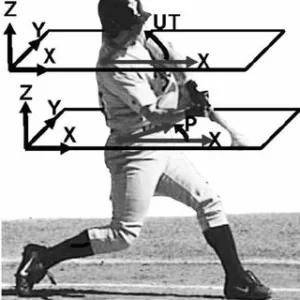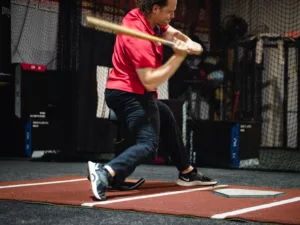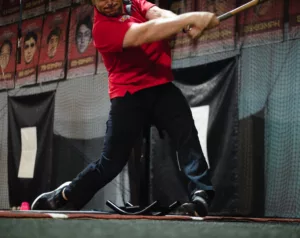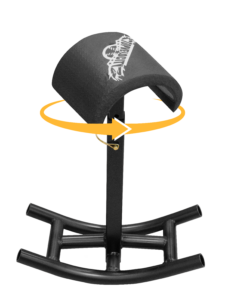The biomechanics of a baseball swing has long been studied in the sports science community. The delicate relationship between the impulse of the lower extremities and the greatest exit velocity of a baseball is a difficult thing to understand. The current study aims to investigate this link, with a focus on the three forms of impulse (X-axis, Z-axis, and XZ-resultant) and their impact on exit velocity. Although the data demonstrate a considerable overall effect, they also show a high amount of diversity among individual individuals. This implies the existence of a group relationship, but with different dynamics for each player. As a result, this link necessitates further investigation and discussion in order to establish a more definitive explanation.
The new research also looks into the function of the load phase in energy production and linear momentum, both of which are important components in bat-to-ball contact. A previous study on the load phase yielded conflicting results, highlighting the need for more extensive research in this area. The load time for each subject could explain the substantial association between bat speed and exit velocity observed in prior investigations. However, further research is required to understand the separate effects of these variables on a swing's impulse and exit velocity. More exact data measures, as well as the inclusion of live pitching in future studies, could help us comprehend the relationship between the load phase and the swing/rotation phase in baseball-hitting biomechanics.
Here are some key takeaways from this article on Secrets of Baseball Swing Biomechanics:
- The study investigated the effect of lower extremity impulse on maximum exit velocity during a baseball swing, revealing a significant relationship between impulse and exit velocity.
- Three types of impulse were examined: X-axis (horizontal), Z-axis (vertical), and XZ-resultant (combined), with the X-axis impulse having a marked effect on exit velocity.
- The load phase of the swing, during which the batter shifts weight and prepares to swing, plays a crucial role in energy production and linear momentum.
- Conflicting findings in previous research on the load phase warrant further investigation to establish the optimal technique for different levels of play.
- The future of baseball swing research should focus on live pitching and advanced data measurements, such as 3D motion capture systems, to better simulate real-world playing conditions.
- The Stride Excelerator 360 is a cutting-edge training tool that helps batters develop a more linear swing by accelerating weight transfer in the X-axis, potentially improving their hitting performance.
Dissecting the Three Types of Impulse: X-axis, Z-axis, and XZ-resultant
 Understanding the complexities of a baseball swing can be difficult, especially when it comes to the forces at work. For a better understanding, we'll break down the three forms of impulse—X-axis, Z-axis, and XZ-result—and their roles in the baseball swing in this section.
Understanding the complexities of a baseball swing can be difficult, especially when it comes to the forces at work. For a better understanding, we'll break down the three forms of impulse—X-axis, Z-axis, and XZ-result—and their roles in the baseball swing in this section.
Let's start with the X-axis impulse. Consider this the horizontal force applied by the batter, which drives the body forward and backward. For example, when a hitter takes a swing, he or she generates force in the opposite direction to propel the bat toward the ball. The X-impulse was found to have a notable impact on the exit velocity in the study, implying that the batter's horizontal force may contribute somewhat more energy than the downward force during the load period.
The Z-axis impulse refers to the force applied vertically or in an up-and-down direction. This force is present during the load phase when the batter shifts its weight and prepares to swing. Although the Z-axis impulse contributes to energy generation, the study found that it has less impact on exit velocity than the X-axis impulse.
Finally, the XZ-resultant impulse is the sum of the X- and Z-axis impulses. It depicts the total force generated by the batter during the swing, taking both horizontal and vertical forces into consideration. The study discovered a substantial link between the XZ-resultant impulse and exit velocity, emphasizing the relevance of X- and Z-axis forces in achieving a successful swing.
Simply put, the baseball swing is a complex combination of forces in several directions. To generate the most exit velocity when striking the ball, a batter must master the balance of horizontal (X-axis) and vertical (Z-axis) forces. Understanding these forces and their interactions allows coaches and players to concentrate on improving technique and, eventually, success on the field.
The Critical Role of the Load Phase in Baseball Swing
 The baseball swing is divided into phases, and the load phase is a critical step that lays the foundation for a hard hit. For a better understanding, we will look at the load phase and its role in generating energy and linear momentum in a simplified manner in this section.
The baseball swing is divided into phases, and the load phase is a critical step that lays the foundation for a hard hit. For a better understanding, we will look at the load phase and its role in generating energy and linear momentum in a simplified manner in this section.
The load phase occurs when the batter transfers his weight, usually moving it back and preparing to swing. This phase acts as a springboard, helping the batter to transfer energy from their body to the bat and, eventually, the ball. The load phase is critical for developing linear momentum, which is the driving force that propels the bat toward the ball. The higher the potential energy that can be harnessed and turned into kinetic energy throughout the swing, the longer and more regulated the load period.
Previous research findings that were contradictory underlined the need for a deeper understanding of the load phase. Some studies have revealed that a prolonged loading time while hitting off a tee might have a negative influence on bat speed and successful hits when moving to live pitching or a pitching machine. These disparities necessitate additional research to determine the best load phase strategy that may be used at different levels of play.
To summarize, the load phase is an important part of the baseball swing because it establishes the groundwork for the development of energy and linear momentum required for a hard hit. Players and coaches can improve their performance by obtaining a better knowledge of this period. Future research can help to determine the appropriate load phase features and give light on how to successfully teach baseball players to maximize their performance on the field.
The Future of Baseball Swing Research: Live Pitching and Advanced Data Measurements
 Sports scientists have been on a never-ending quest to better grasp baseball swing biomechanics. Future studies will be important in simulating real-world playing situations as precisely as feasible. In this section, we'll look at how live pitching and advanced data metrics can help us refine the science of the baseball swing.
Sports scientists have been on a never-ending quest to better grasp baseball swing biomechanics. Future studies will be important in simulating real-world playing situations as precisely as feasible. In this section, we'll look at how live pitching and advanced data metrics can help us refine the science of the baseball swing.
Many studies, use a tee or a pitching machine to conduct biomechanics baseball hitting research. These approaches, however, have limitations because they can not fully simulate the dynamic situations that a batter faces in a live game. Because it delivers a more realistic portrayal of the in-game situation, live pitching is perfect for research. A few studies have successfully conducted a biomechanical analysis of hitting against live pitching, providing vital insights into the mechanics of game situational batting. As a result, including live pitching in future studies is critical to furthering our understanding of the baseball swing.
Aside from live pitching, modern data measuring techniques can considerably improve the quality of research findings. 3D motion captures systems and force plates, for example, can provide exact data on each phase of the swing, allowing researchers to examine biomechanics with more precision. Researchers can solve the limitations of prior studies and create more reliable insights into the many components of the baseball swing, such as the load phase and swing/rotation phase, by employing cutting-edge technologies.
Finally, the integration of live pitching and new data measurement methodologies is critical to the future of baseball swing research. Researchers may delve further into the biomechanics of the baseball swing and provide significant insights that can help players and coaches optimize their training and performance on the field by mimicking real-world playing circumstances and applying cutting-edge technology.
Discover the Power of Stride Excelerator 360: Transform Your Baseball Swing!
 Are you ready to transform your hitting technique and maximize the power of your baseball swing? Consider the Stride Excelerator 360, a game-changing training tool that will assist you in developing a more linear swing by accelerating weight transfer in the X-axis. Feel the difference as the revolutionary rocker design attached to the bottom of the Stride Excelerator 360 supports your linear movement.
Are you ready to transform your hitting technique and maximize the power of your baseball swing? Consider the Stride Excelerator 360, a game-changing training tool that will assist you in developing a more linear swing by accelerating weight transfer in the X-axis. Feel the difference as the revolutionary rocker design attached to the bottom of the Stride Excelerator 360 supports your linear movement.
You'll be able to fine-tune your hitting mechanics and generate more force in the X-axis direction with the Stride Excelerator 360, resulting in enhanced exit velocity and improved batting performance. The Stride Excelerator 360 educates your body to harness the power created during the load phase and efficiently transform it into a powerful and precise hit by offering a smooth, controlled motion that simulates the natural weight shift in a baseball swing.
Don't allow your hitting technique limit you any longer. Purchase the Stride Excelerator 360 to take your game to the next level. Experience the increased power, speed, and consistency that comes from training on this cutting-edge equipment, which is designed to help you excel on the field.
Take action immediately and use the Stride Excelerator 360 to alter your swing! Visit our website to learn more and to order your Stride Excelerator 360 right away. Unleash your inner strength and become the unstoppable force your team requires in the batter's box. The Stride Excelerator 360 and you are the beginning of the future of hitting!





Trackbacks/Pingbacks